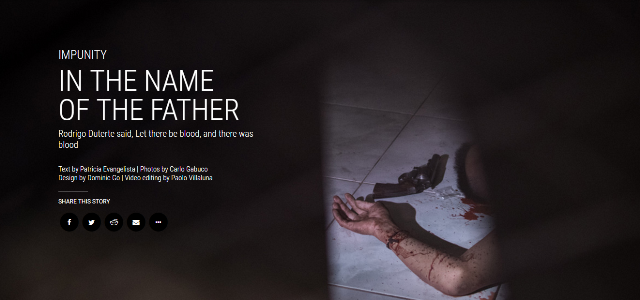Documenting the Drug War: A Befitting Eulogy

Screengrab from Rappler website.
CHEERS TO Rappler for a dramatic counter narrative to the police blotter and the information recorded to prove the success of President Duterte’s drug war. The seven-part Impunity series (November-December 2016) featured on multimedia the findings of journalist Patricia Evangelista and her production crew: Paolo Villaluna, Carlo Gabuco, Rambo Talabong and Dominic Go. Covering the anti-narcotic operations, their effort drew out the stories of parents, children and siblings who lost loved ones to extrajudicial killings (EJKs), some of whom witnessed the murder of a loved one up close.
The series focused on the human story, fleshing out names and identities. We get to know the victims as remembered by their families. We get to share how families have dealt with their loss. Evangelista brings readers face to face with bereavement, the sorrow and loss articulated through anguished tears and fumbling words, the experience of which should serve as an antidote to indifference, to the collective shrug of too many who see the killings as a necessary cost of winning a war, or the cold dismissal of the numbers as collateral damage.
Some of the victims were confessed drug users who already surrendered, making families believe that the police would ask them to submit to treatment in rehab centers. Surely they did not expect their homes to be raided nor to have to witness an execution. The reports also take us to the scenes of tragedy – mothers and children dragged out of their homes by the police, only to return to lifeless husbands and fathers who were said to have fought back. We see on dead bodies dumped in the streets the signs, the cruel “jokes, attempted witticisms, hashtags, happy faces, memes.” We hear the approaching footsteps before the raid, the callous treatment of families told to back off as they would “see it on TV anyway.” We see a mother holding up the sheet that showed she had surrendered to the police, hoping to be saved, but killed anyway in front of her daughter. The masked men who shot her said, “We are Duterte.”
Others killed were clearly innocent, some mistaken for targeted drug personalities. Five year-old Danica Garcia in Pangasinan was clearly collateral damage, accidentally shot as gunmen searched their home for her grandfather, Maximo Garcia, an accused drug dealer. This has given EJK the face of a guiltless child as Danica can no longer remain just a figure or a statistic in the count of faceless casualties.
Evangelista digs deep into the pit of injustice where bereft families have been hurled. Dealing with their loss, they find themselves unable to pay funeral parlors, chosen by the police to collect the bodies. The bereaved could not even hold a proper burial without having to first scrounge for funds.
The series included the larger community who bear the scars of violence. During the Simbang Gabi masses of the Christmas season, the Baclaran Church and Reverend Father Joseph Echano set up an installation of photos gathered from journalists who covered the raids. His church community played a role in raising funds for funeral assistance, requests of which increased when the anti-drug campaign started.
CMFR previously cheered a similar effort by ABS-CBN News to humanize the victims of the war on drugs. The media’s task is to tell the complete story. The stories of the victims should remain part of the assessment. A reminder of the human cost is appropriate, its full measure crucial to media’s obligation to bear witness to the truth and speak it eloquently to power.
Leave a Reply